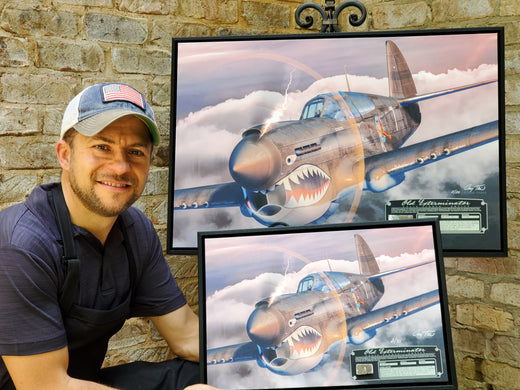This Fine Art Print by Artist Craig Tinder illustrates the determined stance of "Old Exterminator" - the shark-toothed mouth of Col. Robert Scott's venerable P-40E Warhawk from the famed Flying Tigers.

Details About the RELIC:
This P-40E Warhawk Air Intake fragment was discovered nearly 40 km from Murmansk, Russia on the western side of Kola Bay. This component was discovered along the shoreline with many other components from the cockpit. The aircraft was part of the Lend-Lease act between the United States and the former Soviet Union.
The Story Behind the Print:
A West Point graduate, Col. Robert Scott would command the 23rd Fighter Group of the 14th Air Force which was formed by General Claire Chennault. Col. Scott flew nearly 400 combat missions, including many in "Old Exterminator" and received 13 confirmed victories, becoming one of the first combat aces of World War II.
 Col. Robert Scott standing next to P-40 Warhawk "Old Exterminator"
Col. Robert Scott standing next to P-40 Warhawk "Old Exterminator"
Colonel Robert Lee Scott Jr. was a decorated U.S. Air Force pilot who gained fame during World War II for his leadership in the China-Burma-India theater. He is best known for his memoir God is My Co-Pilot, in which he detailed his experiences flying combat missions as the commander of the 23rd Fighter Group, a successor to the legendary Flying Tigers. Scott initially joined the war effort in secret, flying combat missions in China without official authorization, which later earned him recognition as one of the most daring pilots of the era.
His most famous aircraft, a Curtiss P-40 Warhawk dubbed "Old Exterminator," became a symbol of his fearless fighting spirit. The P-40 was known for its rugged build and distinctive shark-mouth design, and Scott used it to execute audacious airstrikes against Japanese forces. Despite the plane's limitations in altitude and speed compared to enemy aircraft, Scott's skill and aggression made him one of the early American aces of the war, with 13 confirmed aerial victories to his name. His repainting of "Old Exterminator" to confuse enemies and simulate additional aircraft was just one of the many innovative tactics he employed.
In addition to his combat prowess, Scott played a crucial role in boosting morale through his leadership and personal courage. He logged countless hours in the air, often flying without adequate resources or support, which contributed to his legend. After the war, he continued to serve in various roles within the Air Force and authored several books recounting his adventures. Scott's legacy, particularly through his P-40 Warhawk "Old Exterminator," remains a significant chapter in the history of American military aviation.
To purchase or see similar items, visit here.
Commissioned by Museums, Treasured by Collectors





Share:
Aleutian Guard, the story behind "Alaskan Tigers"
Restoring History, the story behind "Old Glory"